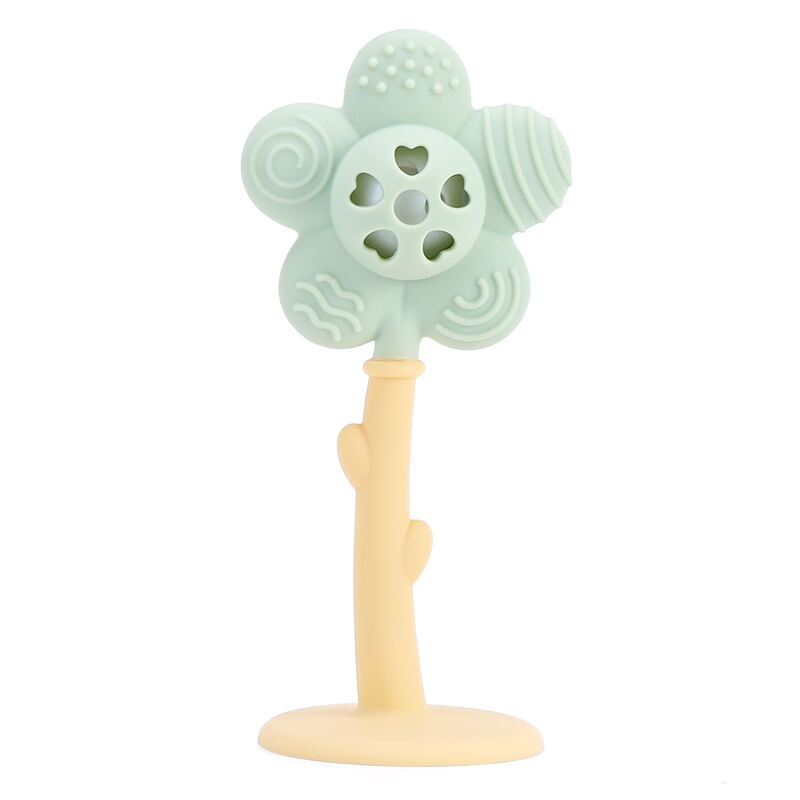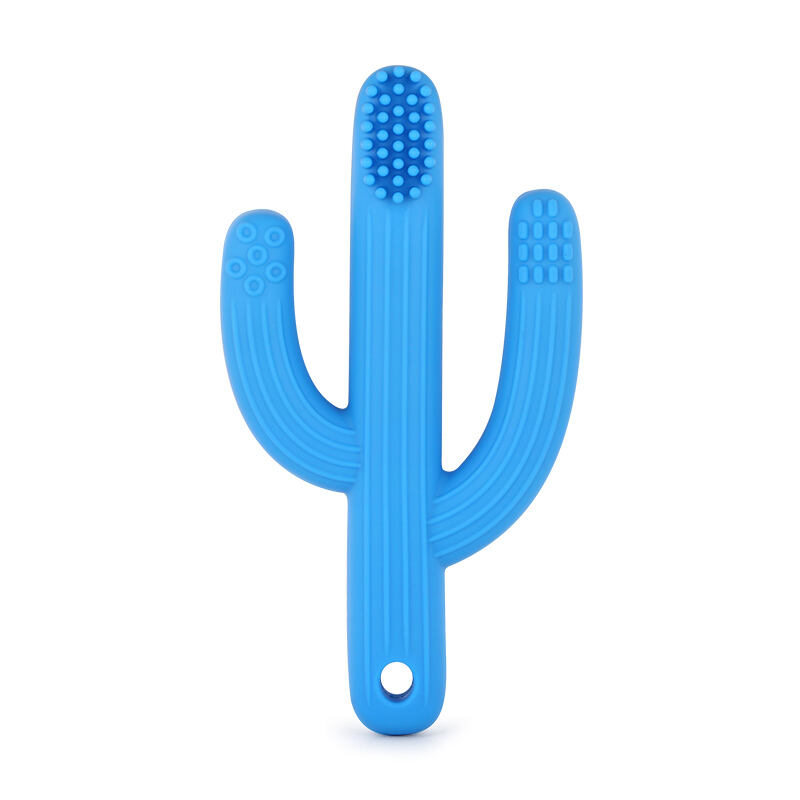Which is better teether or pacifier?
Choosing between a teether and a pacifier can feel tricky, right? Babies have different needs as they grow. For newborns, pacifiers work wonders for soothing and helping them sleep. Once teething starts, though, a teether becomes your go-to for easing gum discomfort. Here’s a quick look at when each is most helpful:
| Age Range | Item Used | Purpose |
|---|---|---|
| Newborn (0-6 mo) | Pacifiers | Soothing, especially during sleep; use orthodontic types to protect gums. |
| Teething (6-24 mo) | Teethers | Soft, textured teethers to soothe discomfort; reduce pacifier use to prevent dental issues. |
Understanding these stages helps you pick what’s best for your baby’s comfort and development.
Key Takeaways
- Teethers help ease gum pain when babies are teething. They also support healthy mouth growth.
- Pacifiers calm babies by satisfying their need to suck. They can also lower the chance of SIDS while sleeping.
- Pick teethers and pacifiers made from safe, non-toxic materials. Orthodontic shapes are better for proper mouth development.
Understanding Teethers and Pacifiers
What Is a Teether?
A teether is a specially designed tool that helps soothe your baby’s gums during teething. Babies love to chew on them because it relieves the discomfort caused by emerging teeth. Teethers come in various shapes, sizes, and materials, making it easy to find one that suits your baby’s needs.
When choosing a teether, safety should be your top priority. Look for options made from non-toxic materials like silicone or BPA-free plastic. These materials ensure your baby isn’t exposed to harmful chemicals. Teethers with different textures are also great. They provide sensory stimulation and help develop oral motor skills. Plus, easy-to-clean designs make your life simpler.
For example, the Sunflower Rattle Teether is a fantastic choice. It combines a fun sunflower design with soothing textures to keep your baby entertained and comfortable.

What Is a Pacifier?
A pacifier is a small, nipple-shaped device that satisfies your baby’s natural sucking reflex. Babies often find comfort in sucking, even when they’re not feeding. Pacifiers can help calm your baby during fussy moments or assist them in falling asleep.
However, prolonged use of pacifiers may lead to dental issues like open bite or overbite. It’s important to monitor how often your baby uses one. Orthodontic pacifiers are a better option as they’re designed to minimize the risk of dental problems.
Key Differences Between Teethers and Pacifiers
Teethers and pacifiers serve different purposes, and understanding these differences can help you decide which one your baby needs.
- Purpose: Teethers soothe gum pain during teething, while pacifiers satisfy the sucking reflex.
- Impact on Oral Development: Teethers promote healthy gum and jaw development. Pacifiers, if overused, can cause dental alignment issues and delay speech development.
- Design: Teethers often have textured surfaces and fun shapes, like the Nontoxic Baby Silicone Teething Toothbrush, which massages gums and promotes oral health. Pacifiers are simpler, focusing on comfort and sucking.

Choosing between the two depends on your baby’s age and needs. A teether is ideal for teething stages, while a pacifier works best for soothing and sleep.
Benefits of Teethers
Soothing Teething Pain
Teething can be a tough time for your baby. You’ve probably noticed the drooling, fussiness, and constant need to chew on things. That’s where a teether comes in handy. It provides your baby with a safe and soothing way to relieve gum discomfort. The gentle pressure from chewing on a teether can ease the pain caused by those tiny teeth pushing through. Plus, many teethers come with textured surfaces that massage the gums, offering extra relief.
Using a teether can also distract your baby from the discomfort. Instead of chewing on random objects, they’ll have a safe and effective tool to focus on. This can make teething a little less stressful for both of you.
Promoting Oral Development
Did you know that a teether does more than just soothe gums? It plays a big role in your baby’s oral development. Chewing on a teether strengthens the jaw, lips, and tongue muscles. These muscles are essential for feeding, chewing, and even speech development later on.
Here’s how it helps:
- It improves jaw strength and coordination, which are crucial for chewing solid foods.
- It enhances the suck/swallow/breathe pattern, making feeding easier and reducing milk dribbling.
- It lays the foundation for speech by building muscle tone and control.
Different textures on teethers, like ridges or bumps, add to this benefit. They encourage your baby to explore various chewing motions, which further develops their oral skills.
Example Products: Sunflower Rattle Teether and Nontoxic Baby Silicone Teething Toothbrush
If you’re looking for a great teether, the Sunflower Rattle Teether is a fantastic option. Its sunflower design isn’t just adorable—it’s functional too. The textured petals provide soothing relief, while the rattle keeps your baby entertained. Plus, it meets safety standards like EN71, ASTM F963-17, and CPSIA, ensuring it’s safe for your little one.

Another excellent choice is the Nontoxic Baby Silicone Teething Toothbrush. This fun cactus-shaped teether doubles as a toothbrush, helping massage gums and promote oral hygiene. Its unique design features three textures—long massage points, raised lines, and soft bristles—offering a variety of soothing sensations.

Both options are safe, effective, and designed to make teething a little easier for your baby.
Benefits of Pacifiers
Satisfying Non-Nutritive Sucking
Babies have a natural urge to suck, even when they’re not feeding. This is called non-nutritive sucking, and it’s a big part of how they self-soothe. Pacifiers are perfect for satisfying this reflex. They give your baby a safe and comforting way to suck, which can help them feel secure and relaxed.
Using a pacifier can also save you from those moments when your baby wants to suck but isn’t hungry. Instead of turning to their thumb or random objects, they’ll have a clean and safe option. Plus, pacifiers are easy to sanitize, making them a more hygienic choice compared to thumb-sucking.
Calming and Comforting Babies
Pacifiers are like magic wands for calming fussy babies. Whether your little one is feeling overwhelmed, tired, or just cranky, a pacifier can work wonders. The sucking motion releases endorphins, which are natural feel-good hormones. This helps your baby feel calm and content.
Pacifiers are especially helpful during stressful situations, like doctor visits or long car rides. They can also make bedtime easier by helping your baby settle down and fall asleep. Did you know pacifiers might even reduce the risk of Sudden Infant Death Syndrome (SIDS)?
Offering a pacifier during sleep can help keep your baby’s airway open and prevent deeper, riskier sleep.
Here’s a quick look at the connection between pacifiers and SIDS:
| Evidence Type | Findings |
|---|---|
| Meta-analysis | Pacifier use is associated with a significant reduction in SIDS risk, especially during sleep. |
| Recommendation | Offering pacifiers during sleep could prevent 1 SIDS death for every 2733 infants using them. |
| Recommendation Level | US Preventive Services Task Force recommends pacifier use for infants up to 1 year of age. |
Popular Pacifier Brands
When it comes to choosing a pacifier, you’ve got plenty of great options. Pediatricians often recommend brands that focus on safety, comfort, and oral health. Here are some top picks:
- Philips Avent Soothie Pacifier: Made from medical-grade silicone, durable, and supports natural oral development.
- MAM Perfect Pacifier: Designed with dentists, it reduces the risk of misaligned teeth and features an ultra-soft nipple.
- NUK Orthodontic Pacifier: Mimics a mother’s nipple and promotes healthy oral development.
- Dr. Brown’s HappyPaci: Lightweight with a butterfly-shaped shield for added comfort.
- Tommee Tippee Closer to Nature Pacifier: Resembles a bottle nipple and supports oral health.
These brands combine functionality with safety, making them excellent choices for your baby’s needs.
Drawbacks of Teethers and Pacifiers
Potential Drawbacks of Teethers
Teethers are great for soothing your baby’s gums, but they’re not without risks. If you don’t choose the right one, it could cause more harm than good. Some teethers are made from unsafe materials, like BPA or phthalates, which can expose your baby to harmful chemicals. Always check the label for non-toxic materials to keep your little one safe.
Another issue is hygiene. Babies love to drop things, and teethers are no exception. If not cleaned regularly, they can become a breeding ground for bacteria. This could lead to infections or upset stomachs. Also, teethers that are too hard might hurt your baby’s delicate gums instead of soothing them.
Cooling teethers can be helpful, but freezing them makes them too hard and risky for your baby’s mouth. Stick to cooling them in the fridge instead.
Potential Drawbacks of Pacifiers
Pacifiers can be lifesavers, but overusing them might lead to dental problems. Prolonged use can interfere with natural dental arch development, causing issues like crowded teeth or improper alignment. It might also lead to a high, narrow palate, which can affect speech later on.
Here are some common dental issues linked to extended pacifier use:
- Open bite: Teeth don’t close properly.
- Buck teeth: Front teeth stick out more than they should.
- Crossbites: Upper teeth fit behind lower teeth.
Research shows that nearly 71% of kids who use pacifiers past age four develop malocclusion. Compare that to just 14% of kids who stop by 24 months. Limiting pacifier use early can help avoid these problems.
Expert Recommendations for Safe Usage
You can minimize risks by following expert tips for both teethers and pacifiers. For teethers, choose BPA-free and non-toxic materials. Look for textured surfaces to soothe gums and ensure they’re firm but not too hard. Cooling teethers are great, but avoid freezing them.
For pacifiers, orthodontic designs are your best bet. They support natural tongue movement and reduce pressure on gums and teeth. Pick ones made from BPA-free silicone or latex and ensure they’re the right size for your baby’s age. A ventilated shield can also prevent skin irritation.
Switch to stage-specific designs as your baby grows. This ensures the product aligns with their developmental needs and keeps them safe.
Choosing Between a Teether and a Pacifier
Using a Teether During Teething Stages
When your baby starts teething, a teether becomes a lifesaver. Around 4 to 6 months, you’ll notice signs like drooling, fussiness, and a strong urge to chew. That’s your cue to introduce a teether. It helps massage sore gums and provides much-needed relief. Look for age-appropriate options with textured surfaces. These not only soothe discomfort but also promote healthy gum development.
For example, the Nontoxic Baby Silicone Teething Toothbrush is a great choice. Its cactus shape and three unique textures—massage points, raised lines, and soft bristles—offer soothing sensations while encouraging oral hygiene.

Using a Pacifier for Comfort and Sleep
Pacifiers are perfect for calming your baby and helping them sleep. To use them effectively, follow these best practices:
- Wait until breastfeeding is well-established (around 3 to 4 weeks).
- Use pacifiers during naps and bedtime to reduce dependency.
- Keep them clean by sanitizing regularly.
- Avoid dipping them in sweeteners to protect your baby’s teeth.
As your baby grows, gradually limit pacifier use during the day. Save it for sleep times and introduce alternatives like a security blanket. A consistent bedtime routine can also help your baby self-soothe without relying on a pacifier.
Factors to Consider Based on Age and Needs
Your baby’s age and developmental milestones play a big role in choosing between a teether and a pacifier. Here’s a quick guide:
| Product Type | Age Range | Developmental Considerations |
|---|---|---|
| Pacifiers | Newborn to 1 year | Soothe and reduce SIDS risk; prolonged use may lead to dental issues like open bite. |
| Teethers | 4 to 6 months+ | Massage sore gums and promote healthy gum development; ensure they’re safe and age-appropriate. |
For pacifiers, orthodontic designs are ideal. They support natural tongue movement and reduce pressure on gums. For teethers, choose non-toxic materials and textured surfaces to maximize comfort and safety.
By considering your baby’s age and needs, you can make the best choice for their comfort and development.
Both teethers and pacifiers offer unique benefits for your baby. Pacifiers soothe newborns and reduce SIDS risk, while teethers ease teething pain and promote oral development. Choose BPA-free, textured options for safety. Your baby’s age and needs should guide your decision. For tailored advice, talk to your pediatrician—they know what’s best!
FAQ
Can I use both a teether and a pacifier for my baby?
Yes, you can! Use a pacifier for soothing and sleep, and a teether for gum relief during teething stages.
How do I clean the Sunflower Rattle Teether?
Wash it with warm, soapy water or sterilize it. Its non-toxic material ensures safety for your baby during use.

Is the Nontoxic Baby Silicone Teething Toothbrush safe for newborns?
It’s best for babies 4 months and older. Its soft silicone design massages gums and promotes oral hygiene safely.




